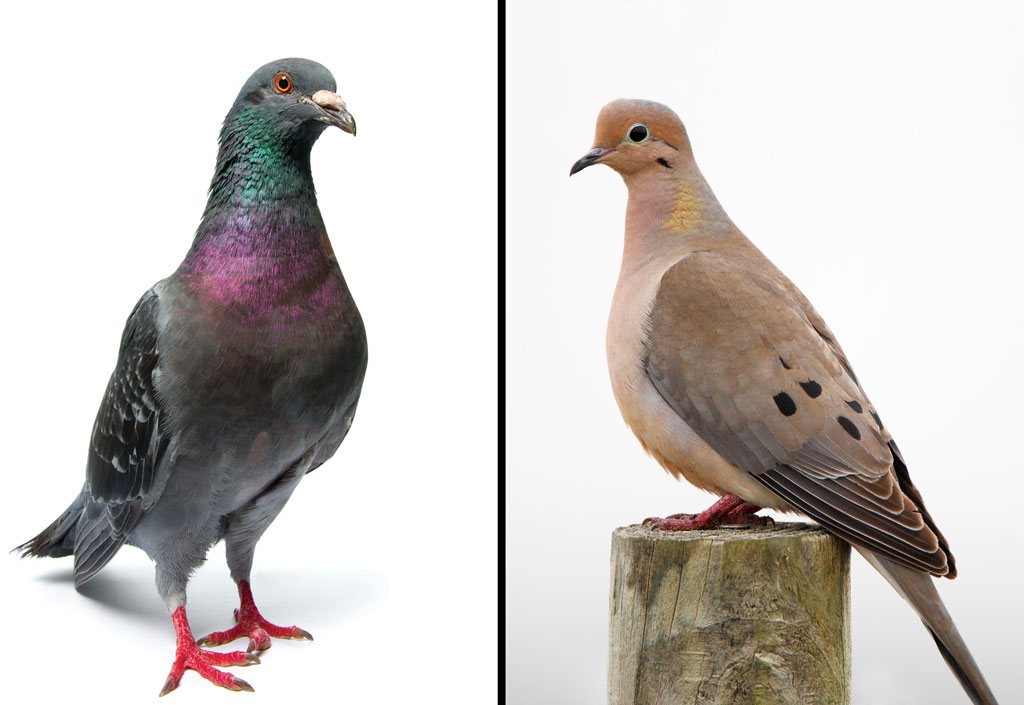Country doves and city pigeons all from the same bird family
Although members of the same bird family, Columbidae, doves and pigeons are viewed through completely different lenses. While “dove” evokes an image of a lovely, graceful bird, often considered a good omen, “pigeon” conjures up a picture of a stubby rat with wings, hanging around parks and fast food restaurants to poop on statues and snap up french fries.
All doves and pigeons have stout, round bodies, short necks, and slim bills and are thickly feathered and highly intelligent. Pigeons, the street-smart cousins from the city, are bigger and more aggressive.
Texas is the year-round home to seven indigenous Columbidae species: mourning dove, white-winged dove, white-tipped dove, band-tailed pigeon, Inca dove (also called Mexican dove), common ground dove, Eurasian collared dove, and rock dove (also known as domestic pigeon).
Only three of these are designated as legal game birds: mourning, white-winged, and white-tipped. They can only be hunted during designated dove seasons.
The Eurasian collared dove, an invasive species, and the rock dove/rock pigeon are both unprotected and can be hunted year-round with a valid license.
The band-tailed pigeon, Inca dove, and common ground dove are protected species in Texas and not hunted.
Not mentioned yet is the red-billed pigeon, which hails from Mexico and Central America. It is a migratory bird that only enters the state to breed in the lower Rio Grande Valley. The Migratory Bird Act makes this bird off-limits to Texas hunters.
SEED EATERS
Doves and pigeons are granivorous, meaning they mainly feed on seeds and grain but will occasionally eat fruits and berries. They like readily available ground feed and will not scratch or work to find food.
Doves and pigeons typically eat hard-coated seeds that are easily accessible, including hackberry, sumac, annual sunflower, pigweed, and croton. The rock dove, which is what most people think of when picturing a pigeon, is known to eat anything tossed its way.
Doves and pigeons consume about 20 percent of their body weight daily and, due to their very active metabolism, poop a lot — a good bit more than other common backyard birds. Much of their food is stored in the crop, an enlarged portion of the esophagus used for temporary food storage.
Their ground feeding habit makes them an easy target for predators such as hawks, falcons, and cats. Nests are easy prey for raccoons, opossums, grackles, and snakes.
LOVE BIRDS
Doves and pigeons are largely monogamous, at least by season and sometimes beyond that. Nesting in Texas typically occurs from March through September, but since the population is year-round, mating can be, too. The male puts on a show for the female by cooing, puffing up his feathers, and strutting in circles around his crush. A typical pair will have two to four broods each year, while more active pairs can have six or so.
TEAMWORK
After mating, the female builds a nest with materials hauled to the location by the male. At first, it is usually a loose, flimsy, somewhat wimpy nest. Doves tend to return to the same nest but might bulk it up a bit each time.
The female typically lays two (sometimes four) plain, white eggs about a week or two after mating. Both parents take turns egg sitting. Should the birds perceive a threat to the nest, it will often be abandoned.
The young, called squabs, hatch about two weeks later. Squabs are fed crop milk by both mom and dad. Crop milk is an esophageal secretion that is higher in protein and fat than milk produced by mammals. After several days of crop milk, squabs dine on regurgitated seeds also provided by the parents. The family vacates the nest after about three weeks to go their separate ways. Territorial birds, they tend to stay within 10 square-miles of the nesting area.
POPULATION CONTROL
Texas is home to the largest dove population in the country. Prolific breeders, doves require population control to keep a healthy, balanced ecosystem, which for many Texans has become a favorite fall sport. Dove hunting, like football, signals the beginning of fall as we darn sure wouldn’t know it by the temperature.
Texans have been hunting and dining on dove throughout the history of the state. In fact, in 1967, evidence was uncovered from an archaeological site in Llano County that prehistoric humans dined on dove. We will leave you with a tried-and-true Texas dove recipe even the pickiest eaters would enjoy.
Chicken-fried dove nuggets
- 2 cups filleted dove breasts
- ½ cup flour
- 2 large eggs
- 1 cup seasoned bread crumbs
- 1 teaspoon of your favorite seasoning (I like Adams Reserve Cowboy Campfire)
- oil for pan frying
Mix flour and ½ teaspoon of seasoning in a small bowl. In another small bowl, whisk eggs. In a third small bowl, mix bread crumbs and remaining seasoning. Dip each piece of dove in the flour and then the egg. Let excess egg drip off then dip it into the seasoned bread crumbs. Pan fry a few dove pieces at a time until golden brown, roughly 30-45 seconds. Let fried dove rest on paper towels to remove excess oil. Serve dove nuggets with a side of your favorite dipping sauce.
FINE-FEATHERED DOVE FACTS
- Doves and pigeons are the most common birds in the world — and the strongest fliers.
- They can live 10-19 years in captivity or about 1-5 years in the wild.
- The rock pigeon is the world’s oldest domesticated bird, starting about 10,000 years ago.
- They are excellent navigators. Trained homing pigeons can return from as far away as 1,100 miles.
- Competitive racing pigeons often fly at speeds of 50-90 mph for short distances and were used during war to carry messages.
- In cold weather, Inca doves are known to form groups, even standing on each other’s backs to stay warm. They rotate so each has a turn on the inside.

